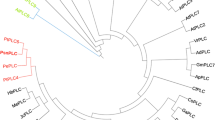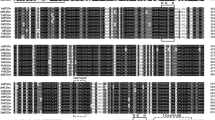Abstract
Phosphoinositide-specific phospholipase C (PI-PLC) is a critical enzyme family, participating in various signal-transduction pathways in eukaryotic cells. However, little information on PI-PLC in plants is available. In this study, a PI-PLC gene, PtoPLC1 was obtained from Populus tomentosa and initial characterized. The recombinant PtoPLC1 protein expressed in vitro was able to hydrolyze phosphatidylinositol 4,5-biophosphate (PIP2) to generate inositol 1,4,5-trisphate (IP3) and 1,2-diacylglycerol (DAG). The catalysis of PIP2 by PtoPLC1 is Ca2+ dependent and the optimum concentration of Ca2+ is 1 μM. These results suggested that PtoPLC1 gene encodes a functional PI-PLC. The qReal-time PCR analysis revealed strong expression of PtoPLC1 in roots, but weak expression in stems and leaves. The gene is strongly induced under high salt, dehydration and ABA. These results suggest that PtoPLC1 might be involved in the signal-transduction pathways of high salt, dehydration and ABA responses in P. tomentosa.





Similar content being viewed by others
Abbreviations
- ABA :
-
Abscisic acid
- DAG :
-
1,2-diacylglycerol
- IP 3 :
-
Inositol 1,4,5-trisphosphate
- PKC :
-
Protein kinase C
- PI-PLC :
-
Phosphoinositide-specific phospholipase C
- PIP 2 :
-
Phosphatidylinositol 4,5-bisphosphate
References
Antonacci S, Natalini A, Cabassi G, Horner D, Ferrante A (2011) Cloning and gene expression analysis of phospholipase C in wounded spinach leaves during post harvest storage. Postharvest Biol Tec 59:43––52
Berridge MJ (1993) Inositol trisphosphate and calcium signaling. Nature 361:315–325
Bradford MM (1976) A rapid and sensitive method for the quantitation of microgram quantities of protein utilizing the principle of protein-dye binding. Anal Biochem 72:248–254
Chen S, Li J, Wang S, Fritz E, Hüttermann A, Altman A (2003) Effects of NaCl on shoot growth, transpiration, ion compartmentation, and transport in regenerated plants of Populus euphratica and Populus tomentosa. Can J Forest Res 33:967–975
Chen J, Xia X, Yin W (2009) Expression profiling and functional characterization of a DREB2-type gene from Populus euphratica. Biochem Bioph Res Co 378: 483–487
Djomo SN, KASMIOUI OE, Ceulemans R (2011) Energy and greenhouse gas balance of bioenergy production from poplar and willow: a review. GCB Bioenergy 3:181–197
Fujita M, Fujita Y, Noutoshi Y, Takahashi F, Narusaka Y, Yamaguchi-Shinozaki K, Shinozaki K (2006) Crosstalk between abiotic and biotic stress responses: a current view from the points of convergence in the stress signaling networks. Curr Opin Plant Biol 9:436–442
Hartati S, Sudarmonowati E, Park YW, Kaku T, Kaida R, Baba K, Hayashi T (2008) Overexpression of poplar cellulase accelerates growth and disturbs the closing movements of leaves in sengon. Plant Physiol 147:552–561
Hirayama T, Ohto C, Mizoguchi T, Shinozaki K (1995) A gene encoding a phosphatidylinositol-specific phospholipase C is induced by dehydration and salt stressin Arabidopsis thaliana. P Natl Acad Sci USA 92:3903–3907
Hunt L, Otterhag L, Lee JC, Lasheen T, Hunt J, Seki M, Shinozaki K, Sommarin M, Gilmour DJ, Pical C (2004) Gene-specific expression and calcium activation of Arabidopsis thaliana phospholipase C isoforms. New Phytol 162:643–654
Kim YJ, Kim JE, Lee JH, Lee MH, Jung HW, Bahk YY, Hwang BK, Hwang I, Kim WT (2004) The Vr-PLC3 gene encodes a putative plasma membrane-localized phosphoinositide-specific phospholipase C whose expression is induced by abiotic stress in mung bean (Vigna radiata L.). FEBS Lett 556:127–136
Kopka J, Pical C, Gray JE, Muller-Rober B (1998) Molecular and enzymaticcharacterization of three phosphoinositide-specific phospholipase C isoforms from potato. Plant Physiol Plant Physiol 116:239–250
Laemmli UK (1970) Cleavage of structural proteins during the assembly of the head of bacteriophage T4. Nature 227:680–685
Melin PM, Pical C, Jergil B, Sommarin M (1992) Polyphosphoinositide phospholipase C in wheat root plasma membranes. Biochim Biophys Acta 1123: 163–169
Mueller-Roeber B, Pical C (2002) Inositol phospholipid metabolism in Arabidopsis. Characterized and putative isoforms of inositol phospholipid kinase and hosphoinositide-specific phospholipase C. Plant Physiol 130:22–46
Munnik T, Testerink C (2009) Plant phospholipid signaling: "in a nutshell". J Lipid Res 50: S260-S265
Otterhag L, Sommarin M, Pical C (2001) N-terminal EF-hand-like domain is required for phosphoinositide-specific phospholipase C activity in Arabidopsis thaliana. FEBS Let 497:165–170
Pan YY, Wang X, Ma LG, Sun DY (2005) Characterization of phosphatidylinositol-specific phospholipase C (PI-PLC) from Lilium daviddi pollen. Plant Cell Physiol 46:1657–1665
Rhee SG (2001) Regulation of phosphoinositide-specific phospholipase C. Annu Rev Biochem 70:281–312
Rozen S, Skaletsky H (2000) Primer3 on the WWW for general users and for biologist programmers. Methods Mol Biol 132:365–386
Shi J, Gonzales RA, Bhattacharyya MK (1995) Characterization of a plasma membrane-associated phosphoinositide-specific phospholipase C from soybean. Plant J 8:381–390
Song M, Liu S, Zhou Z, Han Y (2008) TfPLC1, a gene encoding phosphoinositide-specific phospholipase C, is predominantly expressed in reproductive organs in Torenia fournieri. Sex Plant Reprod 21:259––267
Tamura K, Dudley J, Nei M, Kumar S (2007) MEGA4: molecular evolutionary genetics analysis (MEGA) software version 4.0. Mol Biol Evol 24:1596–1599
Tasma IM, Brendel V, Whitham SA, Bhattacharyya MK (2008) Expression and evolution of the phosphoinositide-specific phospholipase C gene family in Arabidopsis thaliana. Plant Physiol Bioch 46:627–637
Tate BF, Schaller GE, Sussman MR, Crain RC (1989) Characterization of a polyphosphoinositide phospholipase C from the plasma membrane of Avena sativa poly phosphoinositide phospholipase C from the plasma membrane of Avena sativa. Plant Physiol 91:1275––1279
Tripathy MK, Tyagi W, Goswami M, Kaul T, Singla-Pareek S, Deswal R, Reddy MK, Sopory SK (2012) Characterization and functional validation of tobacco PLC Delta for abiotic stress tolerance. Plant Mol Biol Rep 30:488–497
Tuskan GA, Difazio S, Jansson S, Bohlmann J, Grigoriev I, Hellsten U, Putnam N, Ralph S, Rombauts S, Salamov A et al. (2006) The genome of black cottonwood, Populus trichocarpa (Torr. & Gray). Science 313: 1596–1604
Vossen JH, Abd-El-Haliem A, Fradin EF, van den Berg GCM, Ekengren SK, Meijer JGH, Seifi A, Bai Y, ten Have A, Munnik T, Thomma BPHJ, Joosten MHAJ (2010) Identification of tomato phosphatidylinositol-specific phospholipase-C (PI-PLC) family members and the role of PLC4 and PLC6 in HR and disease resistance. Plant J 62:224–239
Wang CR, Yang AF, Yue GD, Gao Q, Yin HY, Zhang JR (2008) Planta 227:1127–1140
Xu X, Cao Z, Liu G, Bhattacharrya MK, Ren D (2004) Cloning and expression of AtPLC6, a gene encoding a phosphatidylinositol-specific phospholipase C in Arabidopsis thaliana. Chinese Sci Bull 49:567–573
Yamamoto YT, Conkling MA, Sussex IM, Irish VF (1995) An Arabidopsisc DNA related to animal phosphoinositide-specific phospholipase C genes. Plant Physio 107:1029–1030
Acknowledgments
This work was supported by the 973 Program (No. 2012CB114501), the State 863 High-Tech Program (No. 2011AA100201), the National Natural Science Foundation of China (No. 30972392) and Beijing Academy of Agriculture and Forestry Sciences Science Foundation for Youths (No. QNJJ201416)
Author information
Authors and Affiliations
Corresponding authors
Electronic supplementary material
Below is the link to the electronic supplementary material.
ESM 1
(DOC 119 kb)
Rights and permissions
About this article
Cite this article
Zhang, J., Zhang, Z., Zhu, D. et al. Expression and initial characterization of a Phosphoinositide-specific phospholipase C from Populus tomentosa . J. Plant Biochem. Biotechnol. 24, 338–346 (2015). https://doi.org/10.1007/s13562-014-0279-1
Received:
Accepted:
Published:
Issue Date:
DOI: https://doi.org/10.1007/s13562-014-0279-1




